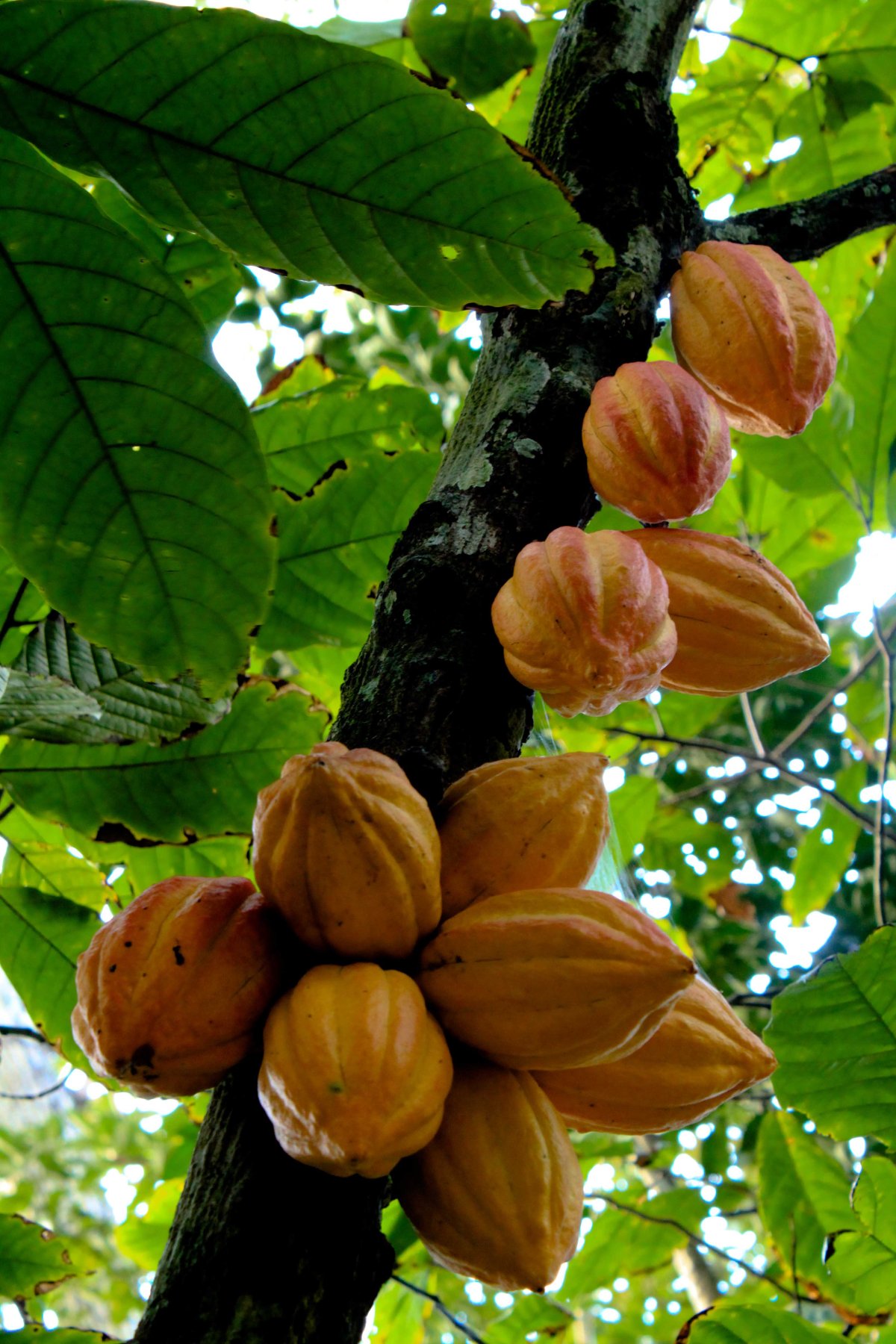The botanical name of cacao is Theobroma cacao. It is an understory tree found in tropical rainforests extending from the Amazonian basin of South America to southern Mexico. Theobroma is a Greek word translated as ‘Food of Gods’: ‘theos’ meaning ‘god’ and ‘broma’ meaning ‘food’.
As far back as 600-400 BCE, societies from the tropics were drinking a bitter chocolate drink made from cacao beans. The beans were fermented, roasted in the sun, ground into powder and mixed with hot water, and made frothy with whisks. This drink was often flavored with maize, vanilla, chili peppers, herbs, and honey. Cocoa was so esteemed by the Ameridians across Mesoamerica that its beans were used as currency and commonly demanded as tribute.
Cocoa was primarily “reserved for adult males, specifically, priests, highest government officials, military officers, distinguished warriors and occasionally sacrificial victims for ritual purposes … Moctezuma, the last Aztec emperor, was inordinately fond of chocolate and he and his court consumed astonishing quantities. His tribute list recorded annual levies of hundreds of cargas or loads, each supposedly of 24,000 seeds. This tribute was carried to Tenochtitlin, now Mexico City, from what is now Vera Cruz, Chiapas and Guerrero” (Sauer, 1995 – pg. 164).
Elites controlled the majority of the production of and trade in cacao, although the local communities also governed some of the production. Two types of orchard-gardens were grown by the Aztecs – household gardens where maize was intercropped with beans, squash, cotton, tuna (cactus) and root crops, and orchards where cocoa and other fruits were grown for commercial purposes and tribute. The Boca Costa region of Central America was particularly renowned for producing the finest cocoa in Mesoamerica. At the time of the Spanish conquest, the Aztec were extracting tribute from the cocoa estates of Boca Costa by taxing the towns controlling production, regardless of their location.
The first Europeans to encounter cacao were Columbus and his crew in 1502, when they captured a canoe at Guanaja that contained what they thought were some sort of almonds. They did not know it was used in a beverage. The first Europeans to encounter cocoa as a drink were Hernando Cortez and his conquistadors when they landed on the east coast of Central America in 1519.
Cortez introduced cacao to Spain in 1528, but in its original form it was not widely consumed, as it was too bitter for most people’s taste. The drinking of cocoa took off in the early decades of the 17th century when Europeans learned to flavor it with sugar and vanilla. By the 1620s, thousands of pounds of cacao were being imported into Spain and Portugal from the Americas.
To supply Europe with cocoa, the Spanish first took over all the indigenous production in Mesoamerica, and then in the early 1600s established plantations in Jamaica, Trinidad and Venezuela. From there they spread cocoa further across the Greater Antilles, Columbia and Ecuador and the French begun growing it in Martinique. By 1670, the Spanish had also introduced cocoa into the Philippines.
The New World remained dominant in world cocoa production until the early 20th century, when West Africa took over leadership. Cocoa and coffee were introduced to São Tomé and Príncipe from Brazil, just a few years before the country gained its independence from Portugal. Within a few decades almost all of the good farmland was covered by extensive plantations (roças) of coffee and cocoa owned by mostly absentee Portuguese landlords. Initially, coffee received the most attention as it produced a crop quickest and therefore generated profits faster. However, coffee could only be grown at the higher elevations, leaving much of the richest farmland underutilized. The surface area of cacao plantations steadily grew throughout the 1800s and by the end of the century São Tomé was the world’s largest producer of cocoa. It still maintains a healthy industry today.
Some 70,000 slaves were brought to São Tomé between 1880 and 1908 to harvest coffee and cocoa. When slavery was legally abolished in 1875, the Portuguese shifted to contract workers from Angola, Cape Verde, and Mozambique. However, the living and working conditions of these indentured laborers were little better than the slaves.
These practices led William Cadbury, head of the British chocolate firm Cadbury’s to investigate the cocoa plantations of São Tomé and Príncipe. Cadbury pressured the Portuguese to reform their labor practices, but rumors of malfeasance persisted, and he sent an agent to investigate in 1905. His subsequent report and a later book by Cadbury himself condemned the Portuguese system as perpetuating de facto slavery. Cadbury’s, and fellow British chocolate manufacturers Fry’s and Rowntree, began a boycott of all cocoa beans grown in the Portuguese territories, until serious labor reforms were made.
Authorities in São Tomé did eventually undertake labor reforms, but not before Cadbury took his business elsewhere and began purchasing cocoa from the Gold Coast of Africa. Cocoa had become an important crop there in the 1890s, grown mostly in smallholdings rather than plantations. In 1911 the Gold Coast became the world’s greatest producer of cocoa, and by the 1920s, 200,000 tons of cocoa was exported annually. Thousands of African brokers and sub-brokers became involved “to bring the export crops to their buying stations” on the coast.
Illustration: The cocoa plant
Bibliography
Bhattacharjee, Ranjana. (2018). Taxonomy and classification of cacao. In: Umaharan, P. (ed.), Achieving sustainable cultivation of cocoa. Burleigh Dodds Science Publishing, Cambridge, UK, (pp.3-18)
Dillinger, T. L., Barriga, P., Escárcega, S., Jimenez, M., Lowe, D. S. and Grivetti, L. E. (2000). Food of the gods: cure for humanity? A cultural history of the medicinal and ritual use of chocolate. The Journal of Nutrition 130(8): 20575–725.
Sauer, J. D. (1995). Historical Geography of Crop Plants: A Select Roster. CRC press, Boca Raton
Walker, T. (2009) Establishing cacao plantation culture in the Atlantic world. In: Grivetti, L and Shapiro, H-Y (eds.) Chocolate: History, culture and heritage. Wiley, Hoboken, New Jersey
